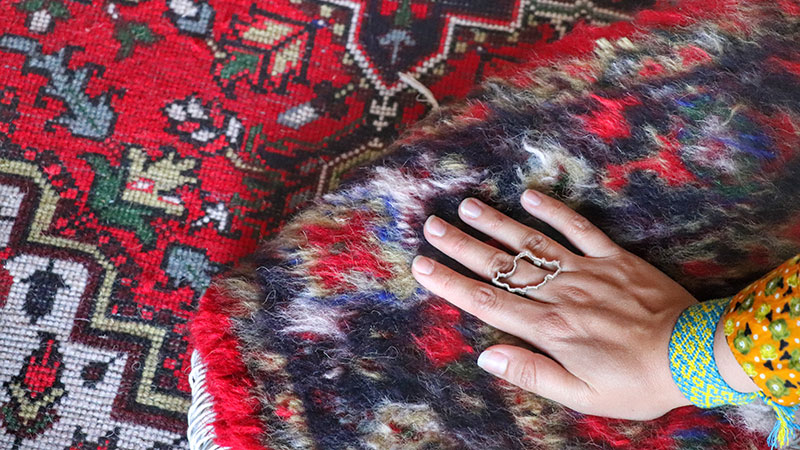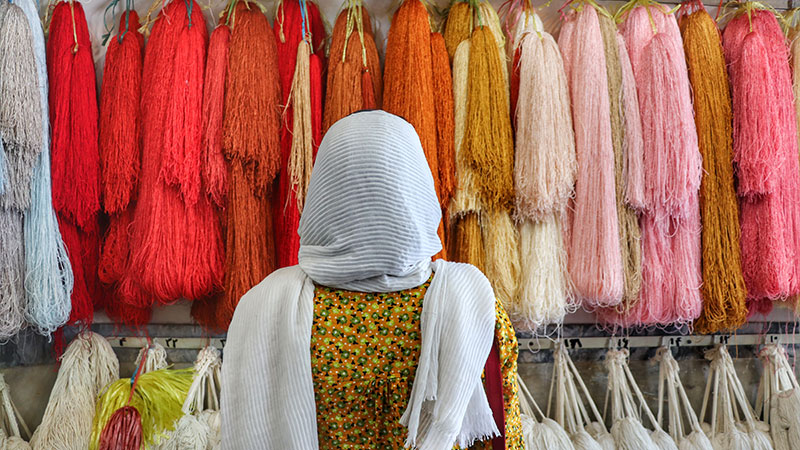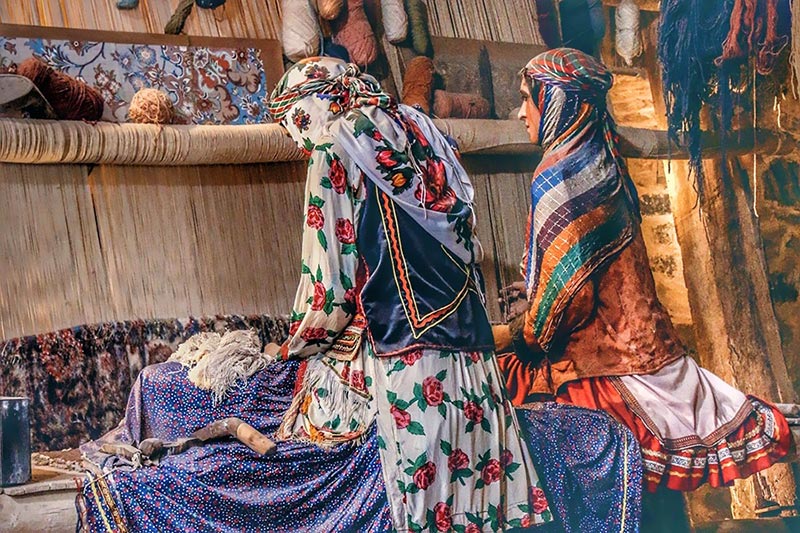 Signin with Google
Signin with Google Signin with Facebook
Signin with Facebook
 Culture,History
Culture,HistoryIranian Carpet, Iranian Notion of Paradise

The image of the Persian paradise under your feet
Walking in a garden changes the spirit of a person and procures a sense of joy and peace. Now, imagine how stepping into a small garden every day would reinforce this feeling each time a little bit more. That's exactly the purpose of Iranian carpets.
It is mentioned in many western records that Iranians walk on gardens, heavens and suchlike that were knitted on warp and woof. Iranian paradise had seven walls to prevent demons from entering inside, the pattern which has been observed in the plan of Persian Gardens as well.
The overall shape of the Iranian carpet is square or rectangle, to remind of the four classical elements, the four main directions and the pattern of gardens. When the circle joined the carpet scheme, it has become to resemble a temple, keeping every sacred thing inside it. In Islamic time the circle placed in the centre of the rectangle area, to be the integrity of existence. The Islamic art pursued to take earth to the sky and bring the sky to earth, and how nice carpet has done this task.

A voyage from the sky to the earth
Golzar or Ferdows was the name of one of the most famous Iranian carpet designs until the Safavid era which exactly was the Iranian pattern of paradise.
Iran carpet weaving was sent to India and especially Lahore instantly after Islam invasion with the Iranians who had migrated from Iran. Later on with the help of Safavid dynasty Indian carpet weaving effectively developed. Since then Indian carpet was largely affected by Persian Carpet and only some indigenous elements such as Elephant has been sat in Iranian designs.
But the influence of paradise or Iranian Pardis is not limited to just India. This image travelled to Jews, as the oldest dated sources about it come from Jews.
Such paradise with such description is basically Iranian whose picture is described in Avesta, the primary collection of religious texts of the Zoroastrianism, and Jam, the most favourite king of Persian myths made this paradise for the first time.

The history of Persian carpets
Iran carpet is a wonderful cultural phenomenon, its beauty is admirable but it is not its appearance that shows its phenomenal importance. In this relatively simple craft, a huge part of culture conceals. There are few Iranian tribes who had not left a trace of them on the carpet.
The historical evidence indicates the knotted-pile carpet or Ghali is the product of the beginning of agriculture in Iran. The word "Ghali" or "Ghalin" is a Sassanian word but because of the lack of vocal "Gh" in Turkish dialect, Ghali is turned to be pronounced as "Hali" in Turkish. There is not a Turkish word for carpet or kilim and related crafts.
In the Sassanid era, lots of Iranian carpets had been exported to China and Tibet to be used in temples for ritual dance must be done over the best carpets. Thus the carpet and weaving of Iran went to China and Tibet.
The weaving technique of the Pazyryk carpet speaks to us
Pazyryk Carpet, manufactured around 500 BCE is the world's oldest pile carpet which was found in a gigantic block of ice in the Saka Iron Age tombs in the Pazyryk Valley of Siberia. It has been woven with the same techniques that are woven in Hamedan, Zanjan or Malayer in Iran after three thousand years. The most ancient carpet belongs to the Iran-west method of weaving and has symmetric knots.
The variant of knots in the Iranian carpet weaving has two main traditions: Symmetric and asymmetric knots. In the east of Iran, regions of Khorasan, Kerman, Kashan, Esfahan and Yazd, the method is an asymmetric knot which is known as Persian knot. And the western tradition has symmetric knots.

There are clear differences between the east and west-Iran weaving techniques which help to recognize each carpet relation to these two methods. For instance, colours are taken from diverse plants in the east and west or the way of fixing colours were different as the east has been used iron sulfate while west used Alum to fix colours with.
Carpet weaving traditions in countries like Uzbekistan, Turkmenistan, Afghanistan, India, Turkey, Caucasus, etc. all are descendants of the tradition of Persian carpet weaving. All the carpet terms in these regions are Iranian and this is the reason why Iran is the ancestor of weaving carpet traditions. Another testimony of this relation is the name of designs and motifs which are in Persian.
The development of the art of weaving
Under the Safavid Dynasty, the art of carpet weaving entered a new era. Geometrical designs were put aside in favour of more harmony, garden inspiration, flowers, animals, and also small characters. Islamic motifs occupied a significant position. Some patterns and designs seen on the vaults, walls, and domes of the mosques entered the composition of carpets. “Toranj” and “Lachak” are two famous patterns inspired by Islam, for instance. Other Iranian symbols are still iconic of the Persian carpets and find their origin in ancient history such as "botteh", a stylized cypress tree shape.
There are many forms of Iranian carpets, such as Medallion carpets with a central medallion surrounded by flowers, arabesques, and animals. Floral carpets, including trees, flowers, and arabesques organized in a geometrical way to evoke the Persian Garden and thus heaven. Prayer rugs, with a motif recalling the Mihrab of the mosques, and thus indicating the direction of Mecca, the holiest city of Islam for Muslims.

If you have ever been into a carpet market, you know what a world of colour and beauty it is. Besides the traditional patterns, each region and city of Iran has developed its own specifications. Thus, sometimes carpets are completely different because of the cultural and natural environment of each region which is seen in the motifs, the texture, yarn, and the type of wool. Kilim, for instance, is a very specific type of flat tapestry-woven carpet originally made by nomads. More than 30 techniques of carpet weaving are used in different types of Iranian carpets.
Persian carpets have remained of the most popular carpets in the world. The Persian carpets are still the first Iranian handicrafts to be exported. The trading of Persian carpets started with the Silk Road merchants and gained huge popularity.
The most famous carpets in the world
To determine the quality of a Persian carpet, several factors must be considered and the number of knots per square meter is the most prominent factor if the carpet is not antique. More knots result in creating more elegant carpets. Using natural colourants like has been the case from prehistory is also a guarantee of bright colours, which will stay the same over the years and not being faded. Most luxurious carpets are weaved with silk which gives a unique shining look to the rug. Yet, the majority of Persian carpets are made with wool, such as camel wool, wool fleece, and Manchester wool. New types can also be woven with cotton yarn and artificial textures such as olefin.
A home is not a home without the Iranian carpet
Iranians have turned the skill of carpet weaving into real art, whose most precious pieces are seen in famous museums all over the world. Yet, it is still a central element for every Iranian household and a portion of national art each Iranian must-have. That's why all types of carpets can be found in Iran with all ranges of prices and sizes because every Iranian brings a little piece of heaven into their own home.

